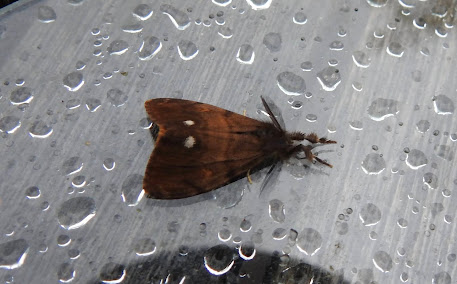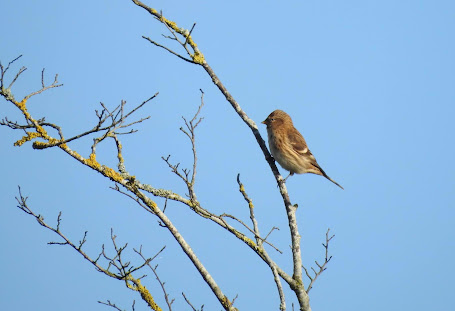I don't know what to say about today. Perhaps that it was in equal measure exhilarating and frustrating. Let me explain.
The east coast of the UK is currently dripping in rarities, I even saw one of them, a Rufous Bushchat, on the Breakfast News this morning. Although it would be unrealistic to hope for anything of that calibre, I was optimistic. For about ten seconds so was Dave. Then he noticed the smoke drifting out of the rear wheel arch of his car.
While we waited for the AA it seemed appropriate to wander along the track to the road and see what we could see. There was nothing too surprising, a few Lesser Redpolls and Redwings flew over, a Marsh Tit or two flitted down the hedge, and a Treecreeper landed not too far away.
 |
| Treecreeper |
Assistance arrived, and I left Dave to his plight, choosing instead to see if any ringers were present. Sure enough they were beavering away. The song of a Firecrest reached my ears while, simultaneously, my eyes took in the tape machine by the mist-net. Clearly Tony and Leigh were also thinking big. They had a Yellow-browed Warbler tape playing too. With the latter species having been found at Grimley, Earlswood, and the centre of Worcester recently, it was definitely worth a go. They were doing alright, lots of captures and three controls, but nothing rare. The controls were of a Lesser Redpoll they had caught here in January 2020, and another one from elsewhere. They still haven't had the results of a previous control, and I understand it depends on the frequency with which other ringers file their reports.
Dave rejoined me with news that his car was undriveable and would be towed away. However, by now it was clear that thrushes were arriving in numbers, so we decided to crack on.
The weather was gloomy, but we weren't. The only problem was estimating how many birds we were seeing as wave after wave of Redwings/Song Thrushes and Fieldfares either flew over, or pitched into the treetops only their calls giving them away. An extremely conservative guesstimate would be 490 Redwings and 60 Fieldfares, while the frequent "tic" calls of Song Thrushes from the bushes indicated that many of them were also present. Add to the mix over 100 Goldfinches, heaps of Lesser Redpolls, and regular Meadow Pipits, Skylarks and various finches. It was all a bit overwhelming.
At one point Dave looked beyond a party of about 200 thrushes and spotted 90 fast flying Golden Plovers heading south. They were extremely distant, but we were happy to name them.
What were we missing? Pretty much all of the birds mentioned so far were seen as little grey blobs against the grey sky, identified only by call. A few allowed views which confirmed what we thought, but the vast majority didn't.
 |
| Fieldfare |
 |
| Redwing |
The above photos were the best I could manage in all this avian turmoil. Admittedly the seven Stonechats we logged all posed quite well, but enough of those get shown on this blog.
Days like this are not unusual at the end of October. In another month the leaves will have blown off the trees and the excitement levels will have returned to normal. We'll be left to wonder whether, if we'd been a bit sharper, a bit less deaf, a bit more keen sighted, we might have picked out the biggy from the swirl of passing mediocrity.
One day, maybe.
Ringing update
Tony and Leigh targeted mainly Meadow Pipits and Redwings on Friday and caught 20 birds. This morning Tony, Leigh, and Kate used feeders and tapes and caught a total of 159 birds including a Lesser Redpoll which had been ringed elsewhere.
Their combined figures (retraps in brackets) are as follows:
Great Spotted Woodpecker 1, Blue Tit 57 (17), Great Tit 11 (6), Long-tailed Tit 1, Goldcrest 4 (2), Wren 8 (2), Redwing 9, Robin 2 (1), Dunnock 1, Meadow Pipit 13, Greenfinch 14, Lesser Redpoll 46 (1), Goldfinch 12.
Although I am a layman in ringing terms, I am struck by the fact that the retraps are prevalent among the resident species as you might expect. This could imply that while the Goldcrests caught might be local birds (a small sample admittedly), migrants like Redwings, Meadow Pipits, and Lesser Redpolls are rarely retrapped. So perhaps the 14 Greenfinches, and 12 Goldfinches were not locals.








































